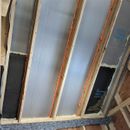Condensation and Vapor Barrier with Rockwool Insulation in Roof
I waited a couple months to put up the poly Iso and now the rockwool is wet, is this a big deal?
My roof assembly is =
-Asphalt – Graces – Advantech roof sheathing. Roof is a 6/12
-Rafters are 2X12’s with 1.5″ air vent from soffit to ridge created with 1.5″ EXP spray-foamed in. Then 8″ rockwool and strapping to hold it in.
I got to this point in the fall and stopped to work on the siding. Now I am back inside and finishing the ceiling. When I removed a piece of the rockwool I found condensation, which makes sense.. I think. All the vapor in the air is going through the Rockwool and condensing on the colder EXP. So I took all the rockwool out and setup fans so it will dry.
My plan now is to let it dry out, put the rockwool back in and add a layer of 2″ poly Iso taped at the seams and edges. My theory is that once the ceiling cavity is air tight from the inside, no vapor can get in and no more condensation. After the 2″ of Poly, I will strap with 2X4’s and then sheetrock.
Does this roof assembly make sense? Thanks for your input!
GBA Detail Library
A collection of one thousand construction details organized by climate and house part












Replies
If that XPS is unfaced, you'll be fine once the new rigid is installed.
I always had issues with this type of baffle install as it relies on diffusion through the rigid to provide drying for any moisture. This is less of an issue if the XPS was thicker (about the same R value as the mineral wool) which would prevent condensation. As is can work but you have to make sure your warm side air barrier is pretty solid. A better option is to pull out the baffles (or drill a bunch of holes in it) and use just the mineral wool plus the interior rigid only for insulation.
Akos, Thanks for the info. I didn't realize the XPS would defuse, that was my main concern.. just getting the vapor stuck.
I am hesitant to drill wholes in my baffles as I worked long and hard on them :) Trying to get my ceiling R - value up to 'code'. I think that my air barrier will be pretty solid as I'm going to use 2x4 strapping and then sheetrock so that I can run wires without puncturing the barrier.
Cheers
Elden,
Impermeable baffles rely on sorption into the wood rafters to remove moisture. That works fine once the warm side air and vapour retarder are in, but (as you have seen) means the assembly isn't half as forgiving as if the baffles are made from something vapour-open.
Mineral wool dries out pretty easily, just allow for lots of air circulation (don't stack all the mineral wool in one place, try to set the pieces so that as much of the exterior is exposed on all sides as possible). Some cheap box fans will help with drying too, moving air really helps here.
Using the polyiso as a taped air/vapor barrier on the inside should keep moisture out of the assembly, and the vent channels will take care of whatever small amount may sneak up there. I would be sure to get things as dry as possible -- and certainly no visible water droplets -- prior to sealing things up though.
BTW, it's best to refer to polyiso as "polyiso" and not "poly". "Poly" usually refers to "polyethylene", which is a very different material, and sometimes can be a big issue when talking about building assemblies and vapor barriers.
Bill
Bill, Thanks for your reply.
I've got 2 box fans on high for the night and things seem to be drying. Nothing was too wet, just drips and a surface layer on wool. I'll make sure everything is dry to the touch tomorrow before putting the wool back in + polyiso.
Also, thanks for the semantics check, that makes sense.
Cheers